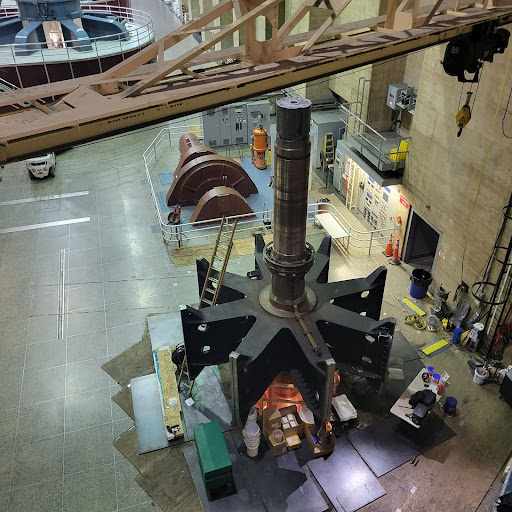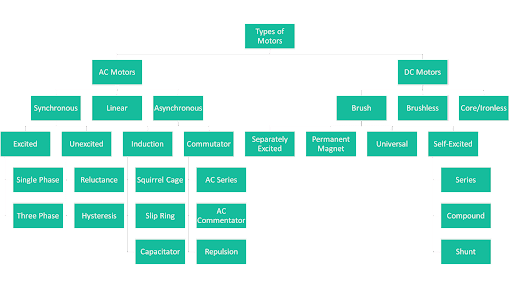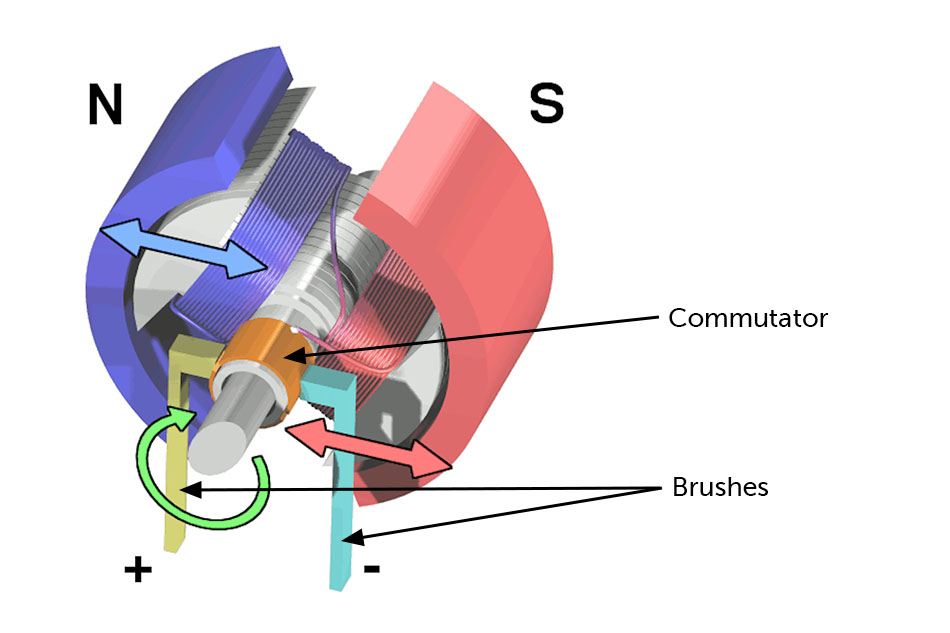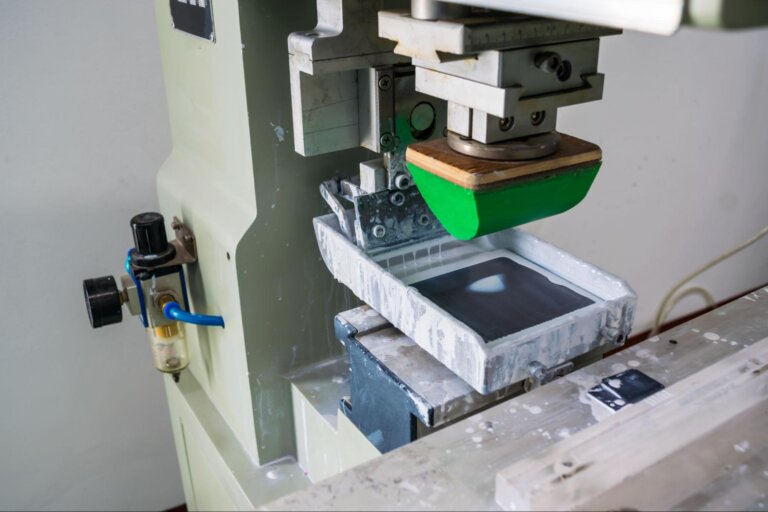Time to read: 6 min
While different electric motors serve vastly different purposes, their core function remains the same—to convert electrical energy into mechanical energy. Motors are the opposite of generators, because they convert electrical energy into mechanical energy, while generators convert another form of energy into electricity (you can see a huge deconstructed generator undergoing maintenance at the Hoover Dam below).
Many resources highlight the characteristics of each unique motor on the market, but motors can be simplified into two overarching categories: AC (alternating current) motors and DC (direct current) motors.

Each type of electric motor has its pros and cons, but this article is meant to provide you with the information you need to choose the right sort ofmotor for your application. Let’s explore how each converts electrical energy, the differences in their construction, and the best use cases for each type.

Power
The glaring difference between the two types of motors is the type of electrical power they use. With AC electricity or alternating current, the voltage reverses every half cycle, which in turn changes the direction of the current. This is done by alternating the polarity at each end of a wire. So, if you take the US standard of 120V/60Hz supply, there are approximately 120 half cycles per second.
With DC electricity, or direct current, the flow of current must remain in a single direction (positive to negative), and voltage must remain constant to keep a steady flow of current. You can think of DC electricity as a battery with clearly marked negative and positive terminals.
AC Electricity for Motors
Electrons don’t travel at a consistent rate in a single direction within a wire propagating AC current as they would with DC—they simply wiggle back and forth and pass along energy (think of Newton’s Cradle).
Alternating current is used for power distribution systems (power to your home/office), for the simple reason that AC is much more efficient when it’s transmitted through wires over a long distance, or for appliances requiring heavy voltage. Why is it better for these applications? Because the back-and-forth “wiggling” of electrons creates an electrical field, a transformer can be used to kick up the voltage and still keep the current relatively low.
The correlation between current and voltage can be found in the following electronics laws:
Power Law: Power=Current * Voltage
Ohm’s Law: Resistance=VoltageCurrent
So, therefore, increasing voltage increases the resistance and decreasing the current with a constant voltage increases resistance.
So what does all of that have to do with an AC motor? Well, basically, AC motors are great for high power appliances/machines that require little precision, like a blender or your washing machine. They’re objects you need to start, and they may ramp up or down in speed, but the difference between 400 RPM and 420 RPM probably isn’t critical. But, AC motors are typically less efficient than DC motors because of energy lost to the secondary magnetic field they generate.
DC Electricity for Motors
DC motors, on the other hand, are all about precision and stability, because the DC power supplying these motors comes in at a constant voltage (there’s no back and forth switching like with AC power). The electrons inside the wire can only travel in a single direction, and they do so at a steady pace.
Again, this is similar to the way a triple-A battery gives your electronics a constant supply of 1.5V (excluding losses) until they die. This is better when you have delicate circuitry/circuit boards or electronics that need a steady supply of energy to function properly, like a laptop.
But wait—if my home is supplying AC power, but my product requires DC power, what do I do?! Most electronics will have an AC to DC converter — it’s what that block on the power cord for your laptop does.
In fact, you can thank the converter on a sewing machine for the inspiration behind the band AC/DC’s name. With a DC motor, you can use a speed controller to adjust the voltage up or down. The controller essentially controls the drive voltage going to the motor to ensure there is sufficient output torque and speed to handle the required load. There is a relationship between drive voltage, speed (RPM), and output torque. Increasing drive voltage increases the RPM while maintaining constant torque.
Construction
While the external housings of both AC and DC motors may not be noticeably different, there are some fundamental differences internally that make them each unique. Keep in mind that the difference is driven by their input/output: AC motors take in an alternating voltage for the sake of efficiency and power, while DC motors maintain a constant voltage for stability.
AC Motor Build
AC motors are simple because the alternating current does all the work. By sending the current through a stationary wire that surrounds a shaft, you create a varying magnetic field, which in turn rotates the shaft.
Remember, AC electricity goes from “positive voltage” to 0 to “negative voltage” at double your frequency (Hz) every second. This means that with the U.S. standard of 60Hz, the current changes direction 120 times a second.
AC motors’ simplicity makes them long-lasting and significantly reduces the chances of mechanical error. The mix between efficiency and long shelf life makes them popular for applications where you don’t want too much energy loss and don’t want to be constantly replacing a motor (think washing machines). Although I depend on my washing machine enough that I’d probably pay every year to get a new one if it broke down—don’t tell LG!
DC Motor Build
The job of a DC motor is to supply a stable and precise output, which makes its construction a little more complex. Returning to the battery example we used earlier, we want the battery to supply a consistent 1.5V to our circuit board, not switching from +1.5 to -1.5V hundreds of times a second that AC power gives us. In that same way, in order for a DC motor to convert the consistent voltage supplied to it, we need a motor construction that will precisely convert that voltage into mechanical energy.
To do so, we need some mechanical functionality to create a rotation that moves the motor. Again, this was easy with AC motors, because AC power naturally swings back and forth, which varies the magnetic field. With DC, the magnetic field will remain the same.
So to counter, we have several rotating coils at the center of a DC motor that connect to a “commutator.” The commutator makes contact with stationary “brushes” of opposite polarities at the exact moment that it needs to change the direction of current to rotate the shaft.

It may be obvious, but the major downside here is loss of efficiency, due to the friction caused by the contact between the commutator and brushes. The loss in efficiency leaves in the form of heat (and sometimes sparks) if you overload the motor.
Function
If you’re sick of reading all the technical details and really just care about what motor works best for your needs, well, it all depends upon your product and its functionality. However, here’s a basic list of advantages for each type of motor to help you figure out which one is best for your application:
Advantages of AC Motors
- Transfers energy more efficiently
- Longer life and less chance of failure
- Produces less heat
- Better for high-power or high-speed applications (washers, refrigerators, machinery)
- Can tie directly into a home or office outlet, without a converter
Advantages of DC Motors
- Low electromagnetic interference (great for sensitive electronic devices)
- Stability for circuit boards and sensitive electronics
- You can run your product on battery power
- Better speed control due to more constant torque
- May require more maintenance due to brushes in the motor
Main Takeaways
In reality, there will likely be several factors in your design that will dictate the type of motor you choose. If you’re using circuit boards or batteries and require fine-tuning on your speed controls, a DC motor is the way to go. If you’re going for high power, efficiency, and a long-lasting powerplant, an AC motor will do the trick.
For all of your custom motor components, AC or DC, look no further than Fictiv. A wide range of materials can be CNC machined to extremely tight tolerances to ensure your motor can maintain precision and reliability. And with the CNC process, you’ll get your parts quickly, which is critical for both custom one-off CNC machined motor parts, maintenance/repair parts, and production-scale components.
Start Your Next Project With Fictiv
If you’re tasked with sourcing and supplying CNC machined motor parts, Fictiv is your operating system for custom manufacturing that makes part procurement faster, easier, and more efficient. In other words, Fictiv lets engineers, like you, engineer.










